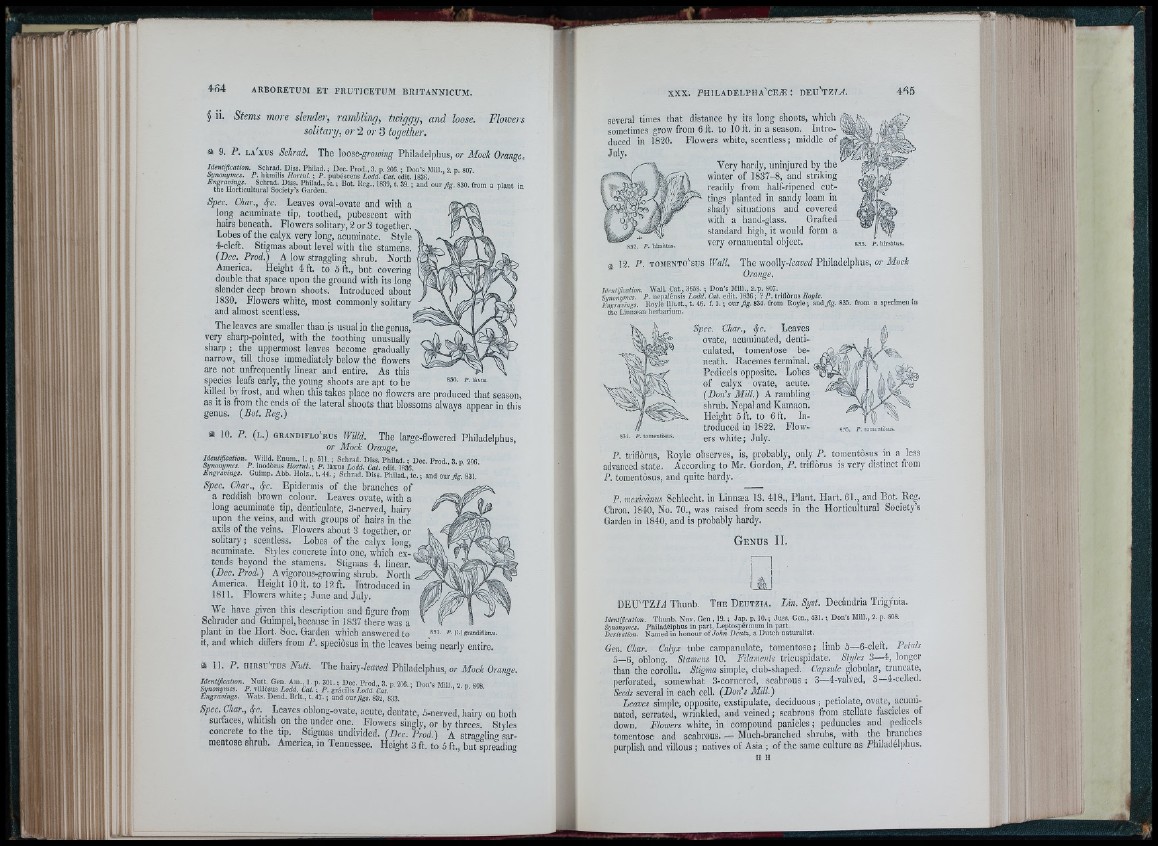
§ ii. Stems more slender, ramhling, twiggy, and loose. Floioeis
830.P. Iáxu6
solitary, or 2 or 3 together.
tt 9. P. l a ' x u s Schrad. The loose-growing Philadélphus, or Mock Orange,
identification. Schrad. Diss. Philad. ; Dec. Prod., 3. p. 206. : Don’s Mill.. 2 p. 807
Synonymes. F. hilraills Hortul. ; F . pubescens I.odd. Cat. edit. 1836.
^'.‘Ì r S L u S a / t c E I P i S S . ' '- ' *• ““■■fr" “ >’">■“ ‘”
Spco. Char., 4c. Leaves oval-ovate and with a
long acuminate tip, toothed, pubescent with
hairs beneath. Flowers solitary, 2 or 3 together.
Lobes o f the calyx very long, acuminate. Style
4-cleft. Stigmas about level with the stamens.
(Dec. Prod) A low straggling shrub. North
America. Height 4 ft. to S ft., but covering
double that space upon the ground with its long
slender deep brown shoots. Introduced about
1830. Flowers white, most commonly solitary
and almost scentless.
Theleaves are smaller than,is usuai in tiie genus,
very sharp-pointed, with the toothing unusually
sharp ; the uppermost leaves become gradually
narrow, till those immediately below the flowers
are not unfrequently linear and entire. As this
species leafs early, the young shoots are apt to be — -------
killed by frost, and when this takes place no flowers are produced that season,
as it is from the ends of the lateral shoots that blossoms always appear in this
genus. (Bot. Reg.)
t t 10. P. ( h . ) g r a n d i f l o ' e u s Wil/d.
The large-flowered Philadélphus,
or Mock .......
Identification. iK im . Enum., 1, p. 611. ; Schrad. Diss. Philad. ; Dec. P ro d .,3 .p 206
Synonymes. iP. inodòrus ; P. láxus ¿odd. Cai. edit 1836
Engravings. Guimp. Abb. Holz., t. 44. j Schrad. Diss. Philad., ic. ; and our j?g-. 831.
Spec. Char., 4c. Epidermis of the branches of
a reddish brown colour. Leaves ovate, with a
long acuminate tip, denticulate, 3-nerved, hairy
upon the veins, and with groups of hairs in the
axils of the veins. Flowers about 3 together, or
solitary ; scentless. Lobes of the calyx long,
acuminate. Styles concrete into one, which ex- «
tends beyond the stamens. Stigmas 4, linear. '
(Dec. Prod.) A vigorous-growing shrub. North
America. Height 10 ft. to 12 ft. Introduced in
1811. Flowerswhite; June and July.
We have given this description and figure from
Schrader and Guinipei, because in 1837 there was a
p la n tin the Hort. Soc. Garden which answered to ,“ >■ (i.) (umaiflò™.
it, and which differs from P. speciòsus in the loaves being nearly entire.
s 11. P. HIESU'TUS Nutt. The hairy-leaved Philadélphus, or Mock Orange.
/ifíníiScoíion. Nutt. Gen Am. l .p . 301.1 Doc. Prod., 3. p. Synonyntes. P. vùlòsas Lodd. Cat. \ P. gxiciWs Lodd ta t 206.1 Don’s iMiuilil. , z2, pp. e8u0s8.
Engravings. Wats. Dend. Brit., t. 47. ; and our Jigs. 832, 833.
Spec.Char., 4 c. Leaves oblong-ovate, acute, dentate, S-nerved, hairy on both
surfaces, whitish on the under one. Flowers singly, or by threes. Stvles
concrete to the tip. Stigmas undivided. (Dec. Prod.) A straggling sarmentóse
shrub. America, in Tennessee. Height 3 ft. to 5 ft., but spre'adiiig
several times that distance by its long shoots, which .!
sometimes grow from 6 ft. to 10 ft. in a season. Introduced
in 1820. Flowers white, scentless; middle of
July.
Very hardy, uninjured by the
winter of 1837-8, and striking
readily from half-ripened cuttings
planted in sandy loam in
shady situations and covered
with a hand-glass. Grafted
standard high, it would form a
832. P. wnMu*. very ornamental object. 833. P. hirsùUu.
^ 12. P. TOMENTo'sus Wail. The woolly-/i?ayi?/Philadélphus, or il/ocA:
Orange.
Idvnliñcation. Wall. C a t, 3668. ; Don’s Mill., 2. p. 807.
S m o n iim e s . P . nepalensis Loifrf. Caí. edit. 1836 ; ? P . triflòrus
Kttgravings. Uoyie IHust., t. 46. f. 1. ; o u r ^ . 834. from Royle; an d jig . 835. from a specimen In
the Linnaian herbarium.
Char., <^o. Leaves
ovate, acuminated, denticulated,
tomentose beneath.
Racemes terminal.
Pedicels opposite. Lobes
of calyx ovate, acute.
(Don's Mill.) A rambling
shrub. Nepal and Kamaon.
Height 5 ft. to 6 ft. Introduced
in 1822. Flowers
white; July.
S.l-I. p. tomentòsus.
rt
P- tomc-ntòsus.
a less
t from
P. triflòrus, Royle observes, is, probably, only P. tomentòsus in ;
advanced state. According to Mr. Gordon, P . triflòrus is very distinci
P. tomentòsus, and quite hardy.
P. mexicànus Schlecht, in Linnaea 13. 418., Plant. Hart. 61., and Bot. Reg.
Chron. 1840, No. 70., was raised from seeds in the Horticultural Society’s
Garden in 1840, and is probably hardy.
G e n u s I I .
DEU'TZ/fl Thunb. T h e D e u t z i a . Lin. Syst. Decèndria Trigynia.
Identification. Thunb. Nov. Gen , 19. ; Jap. p. 10. ; Juss. Gen., 431. ; Don’s Mill., 2. p. 808.
Synonymes. Philadélphus in part, Leptospernnim in part.
Derivation. Named in honour oiJo h n D e u l x , a Dutch naturalist.
Gen. Char. Calyx tube campanulate, tomentose; limb 5—6-clcft. Pctah
5—6, oblong. Stamens 10. Filaments tricuspidate. Styles 3—4, longer
than the corolla. Stigma simple, club-shaped. Capsule globular, truncate,
perforated, somewhat 3-cornered, scabrous ; 3—4-valved, 3—4-celled.
Seeds several in each cell. (Doris Mill.)
Leaves simple, opposite, exstipulate, deciduous; petiolate, ovate, acuminated,
serrated, wrinkled, and veined ; scabrous from stellate fascicles of
down. Flowers white, in compound panicles; peduncles and pedicels
tomentose and scabrous. — Much-branched shrubs, with the branches
purplish and villous ; natives of Asia ; of the same culture as Philadélphus. H H